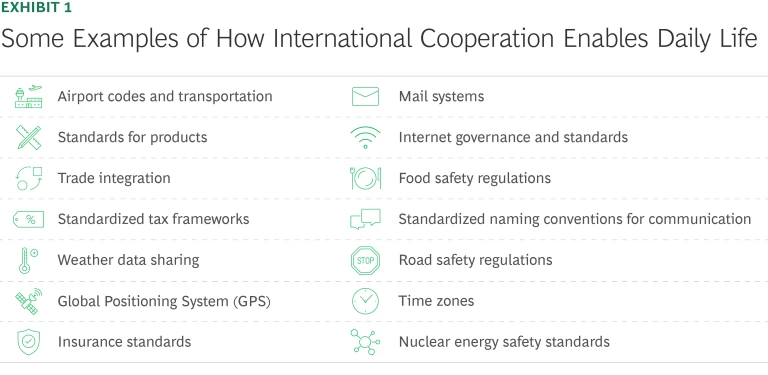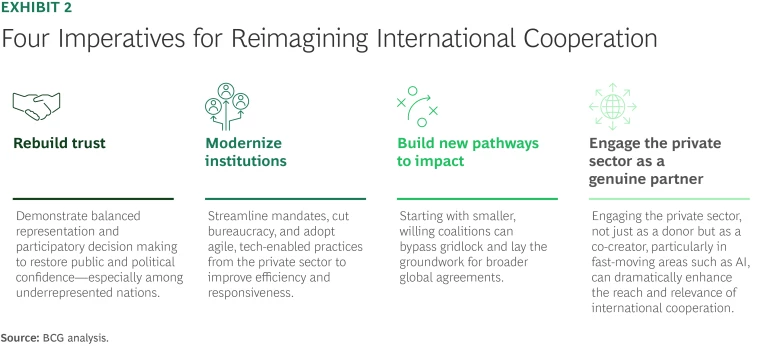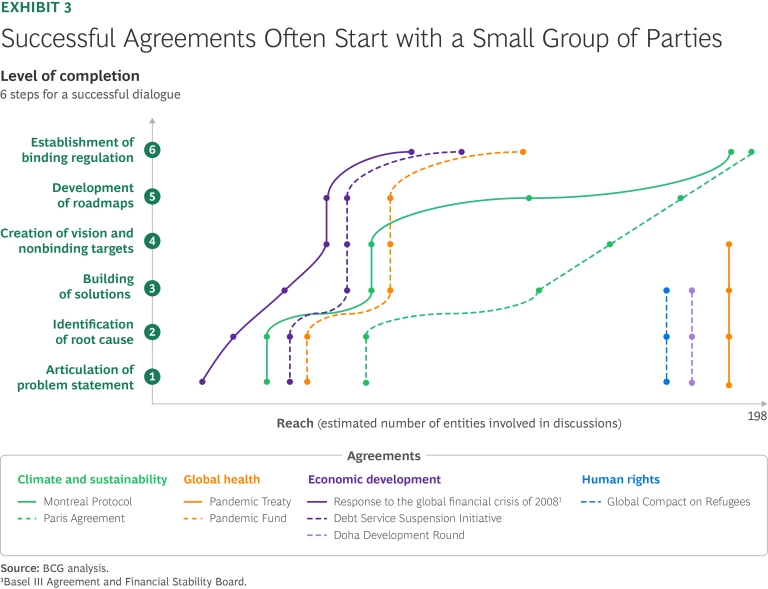It may not always be obvious, but international cooperation shapes much of our daily lives. Air travel is safer and more efficient thanks to flyover conventions, standardized airport codes, and aviation regulations. Weather forecasting is more accurate because countries share meteorological data. Even reading this article on your phone is possible thanks to unified global internet protocols.
And yet, international cooperation is under pressure with many questioning its relevance and effectiveness. Such skepticism isn’t surprising given how much the world has changed since institutions like the United Nations, the World Bank, and the International Monetary Fund were founded eight decades ago. These organizations increasingly recognize the need to adapt to today’s geopolitical and economic realities as well as the broad shift across both private and public sectors to a more dynamic, agile way of working. In March of this year, for example, UN Secretary-General António Guterres launched the UN80 Initiative to ensure “an even stronger and more effective United Nations that delivers for people and is tuned to the 21st century.”
How can these international institutions reimagine their roles—and what concrete steps can they take to remain fit for the future? To make multilateralism more effective and resilient, both the institutions themselves and the member countries that govern them can focus on four key areas: rebuilding trust, modernizing institutions, building new pathways for impact, and engaging the private sector as a genuine partner. Indeed, governments from all corners of the globe can come together to take meaningful steps to renew and reinforce international cooperation through steadfast commitment, tangible reforms, and pragmatic cooperation.
The Power of International Cooperation
Multilateralism has delivered undeniable benefits across a range of critical areas—from environmental protection to financial stability, from global health to security. Some of these are everyday conveniences we take for granted. (See Exhibit 1.)

Others, such as the international effort to phase out ozone-depleting chemicals or eradicate disease, have driven transformative change. (See sidebar, “Broad Collaboration, Deep Impact.”)
Broad Collaboration, Deep Impact
Internet protocols. Since their global adoption in the early 1980s, TCP/IP protocols have enabled unprecedented global connectivity, standardizing communication across billions of digital devices and underpinning the modern internet. Meanwhile, the Internet Corporation for Assigned Names and Numbers (ICANN) coordinates global domain names and IP addresses, enabling a unified global internet.
Ozone protection. In 1987, the UN orchestrated a global agreement to eliminate substances depleting the ozone layer. The Montreal Protocol, ratified by 198 parties, regulated the production and consumption of nearly 100 harmful chemicals. Thanks to this effort, global production of these substances plummeted from 1.5 million metric tons in the 1980s to nearly zero by the early 2010s. Scientists estimate that without this treaty, global temperatures would have increased by an additional 0.5 to 1 degree Fahrenheit by 2100.
Smallpox eradication. The World Health Organization (WHO) led a coalition to eradicate smallpox, coordinating vaccine production and distribution across the world. At its peak, smallpox killed 30% of those infected, mainly children. By 1980, after concerted international efforts, smallpox was declared eradicated—saving an estimated 2 million lives per year.
Nonproliferation of weapons. Multilateral agreements like the Chemical Weapons Treaty have limited the proliferation of dangerous materials and helped mitigate conflict. Established in 1993, the treaty has been signed by 193 countries, making it one of the most widely adopted arms control agreements. It has led to the destruction of over 99% of declared chemical weapons stockpiles worldwide. Ongoing verification and compliance efforts continue to prevent the resurgence of chemical warfare threats.
While these successes stem from focused, coordinated efforts, the collective challenges humanity faces today—climate change, cybersecurity, pandemics, and many others—are broader in scale and complexity, requiring an even deeper level of international cooperation.
Consider the intersection of artificial intelligence, cybersecurity, information, and misinformation. The advent of AI has opened incredible opportunity for growth and productivity. Alongside those powerful benefits, however, AI also raises new challenges, including in the areas of misinformation, bias, and surveillance. One MIT study found that false news stories are 70% more likely to be reshared than true stories and spread six times faster. The risk of bad actors using AI to create discord through misinformation or engage in more sophisticated cybercrimes remains very high. And the costs of these attacks continue to escalate. In 2024, the global average cost of a data breach reached a record high of $4.9 million, a 10% increase over the previous year, according to an IBM report. Without coordinated efforts to regulate AI across borders, efforts to curb misinformation, bias, and digital threats will prove ineffective.
An understanding of risks such as these should drive us to call for more international collaboration in the face of headwinds. Indeed, even countries with strained relations have come together at the International Telecommunication Union (ITU) to negotiate and agree upon digital and emerging technology issues.
Stay ahead with BCG insights on social impact
Reinventing Multilateralism
Although the benefits of effective multilateralism are often underappreciated, the approaches to rejuvenate existing institutions are quite clear. We see four imperatives to achieve a multilateralism that is fit for the future. (See Exhibit 2.)

Imperative 1: Rebuild trust. People need to see and believe that multilateralism delivers real results. To rebuild trust, it is up to governments and the multilaterals themselves to effectively showcase successes and highlight how international cooperation directly benefits everyday lives. Such evidence can help change the narrative from bureaucratic gridlock to a focus on action and impact.
At the same time, trust hinges on balanced representation and participatory decision making. Yet many institutions still reflect the geopolitical realities of eight decades ago, ignoring the massive shifts since then.
Countries can come together to reform the governance frameworks of these institutions to make them more inclusive and responsive. More participatory engagement with a broader set of nations—especially emerging markets and developing economies (EMDEs)—along with transparency in decision-making processes can help restore credibility. For these EMDEs, multilateral institutions are more than platforms for diplomacy—they are gateways to global value chains, rule-based systems, and fair competition. These frameworks offer a crucial path for broad-based economic advancement, enabling countries to participate more effectively and meaningfully in the global economy.
The emergence of more localized organizations with specific mandates and an increasing emphasis on the Global South marks a reaction to the inefficiencies and lack of representation in these existing global governance structures. For example, Brazil, Russia, India, China, and South Africa, collectively referred to as the BRICS, worked together to create the New Development Bank a decade ago to provide an alternative mechanism for financing infrastructure and sustainable development. The institution, which now includes an additional five countries, is expanding with a view to explicitly offer a counterbalance to those institutions largely dominated by western nations.
Meanwhile, 54 countries have come together in the African Continental Free Trade Area (AfCFTA) with a view to establish a single market for goods and services, facilitate the movement of people and investments, and promote industrial development across Africa. This free trade area is now the largest such arrangement in the world by number of participating nations, encompassing over 1.4 billion people with a combined GDP exceeding $3 trillion.
Imperative 2: Modernize institutions. With more than 60 distinct entities within the broader UN system, there are inevitable inefficiencies and redundancies. Four specific pathways to modernize these organizations include:
- Evaluate mandates. This can enable institutions to streamline operations and improve impact. A detailed and systematic review of institutional mandates and their implementation to date will shed light on effectiveness and eliminate outdated efforts. Doing so in a manner that makes the scope and scale of the mandates that member states have placed upon these institutions transparent and abundantly clear will be essential.
- Rationalize overlapping efforts. The proliferation of mandates over the years has contributed to the development of duplicative programs, projects, entities, and capabilities. That duplication, in turn, has resulted in the suboptimal allocation of resources and uneven impact. Institutions have an opportunity to identify and appropriately consolidate these overlapping efforts, drawing upon the lessons and methodologies deployed in private sector mergers and postmerger integrations. In doing so, they will be in a stronger position to deliver synergies while also increasing impact.
- Minimize bureaucracy. Institutions can reduce bureaucracy and improve decision making by driving a dispassionate, thorough, and rigorous re-wiring of all major and minor operating processes and policies. Leveraging new technology, including predictive and generative AI, can enhance productivity, eliminate inefficiencies, and standardize investments across the system.
- Embrace the private sector and adopt its best practices. The private sector has valuable experience when it comes to agile ways of working, talent deployment, performance management, behavioral science, and procurement. Adopting these practices can help institutions become more results-driven, address immediate challenges and build a culture of efficiency, intrapreneurship (entrepreneurship within an organization), and thoughtful risk-taking.
Driving this level of change must be done carefully and be guided by a set of principles that reflect the values of these institutions. (See sidebar, “Eight Principles for Effective Reform.”)
Eight Principles for Effective Reform
- Protection of the core mandate: Anchor decisions on the organization’s fundamental mandate. This includes focusing efforts where the mandate is most directly advanced and global value is clearest.
- Emphasis on beneficiary outcomes: In assessing tradeoffs, prioritize programs that are mission critical. To ensure impact, organizations can clearly focus on how to deliver for beneficiaries—not on protecting the survival of their own institution.
- Respect for the dignity of personnel: Approach organizational change with transparency, empathy, and integrity. And recognize the institutional knowledge, dedication, and human capital at the core of mission delivery.
- Bold and transformative thinking: Remain open to a broad range of solutions, including capability shifts, consolidation, structural redesign, partnerships, and technology. Be careful that legacy structures or the notion of sunk costs do not dictate the path forward.
- Quick and decisive action: Establish clear governance and decision making. These can help respond to evolving needs with urgency. Rapidly socialize plans for change among stakeholders while avoiding delays due to desire for consensus. And empower leaders to take timely, well-informed action.
- A focus on long-term resilience: Ensure that the “right sizing” and “right scoping” of efforts drive near-term operational sustainability and enhance adaptability and relevance. Ultimately, the goal is for any decisions on how to adjust operations to drive both fiscal discipline and future readiness.
- A strong role and voice for member states: Acknowledge the important role of member states and engage them with transparency and accountability. Work to ensure that the perspectives of member states are leveraged to drive actions that are focused on institutional mandates—not on idiosyncratic wishes or pet projects.
- A neutral, independent, objective, and transparent process: Promote accountability by clearly documenting decisions, applying consistent criteria, and inviting external perspectives where appropriate. And use objective data to inform prioritization, resource allocation, and structural change and establish clear metrics for both efficiency and effectiveness.
Imperative 3: Build new pathways to impact. Expecting consensus from nearly 200 parties at the outset of a negotiation or document preparation is unrealistic. Starting with smaller agreements among key players can demonstrate viability, build momentum, and create pathways for broader global buy-in. Regional and issue-specific coalitions can help break deadlocks and set precedents for larger agreements.
It’s hardly surprising then that some of the most successful agreements—such as those tackling CFC emissions and the global financial crisis—began with small, committed coalitions before scaling up. (See Exhibit 3.)

The breakdown of initiatives like the Pandemic Treaty and the Doha Development Round illustrates what happens when negotiations begin with overly large groups, making consensus nearly impossible. At the same time, even those that start with small coalitions still face challenges in reaching an agreement that ultimately encompasses a large group of players. In Exhibit 3, only two of the major efforts we studied—the Montreal Protocol to drive the phaseout of CFCs and the Paris Agreement—reached scaled adoption with meaningful results.
Certainly, agreement is not a guarantee of full-scale action. Although the Montreal Protocol was widely implemented, implementation of the Paris Agreement is varied. But the long-term chances of success do seem to improve by starting with a targeted group of parties and building support from there.
Multilateral institutions can develop phased negotiation frameworks and encourage member states to use them. This approach allows agreements to begin with willing participants before expanding more broadly. Additionally, providing structured incentives for early adopters can encourage wider participation over time.
Imperative 4: Engage the private sector as a genuine partner. Businesses need not be seen merely as funders, but as collaborators. The private sector moves faster and often has more expertise in emerging areas like AI and sustainability. Corporations also bring valuable insights into market trends, supply chain challenges, and technological advancements. Multinational companies, in particular, are among the biggest beneficiaries of multilateral frameworks that reduce uncertainty and establish global standards—giving them strong incentives to support and uphold international cooperation. Engaging these actors meaningfully and more often can strengthen the connective tissue among nations and their global institutions.
One successful example is the Water Resilience Coalition, sponsored by the UN Global Compact and the Pacific Institute. Through private-sector partnerships, this initiative has launched 21 collective action projects addressing water scarcity across 15 regions. Such models can be replicated across other global challenges, harnessing business innovation for maximum impact.
From tackling global health issues to managing AI risks, the world’s most pressing challenges require coordinated action. The UN, the World Bank, the International Monetary Fund, and other institutions that govern international cooperation can evolve to meet modern needs. By rebuilding trust, streamlining operations and mandates, modernizing decision making, and engaging the private sector as a true partner, they can deliver meaningful impact for people around the world—both today and for generations to come.





